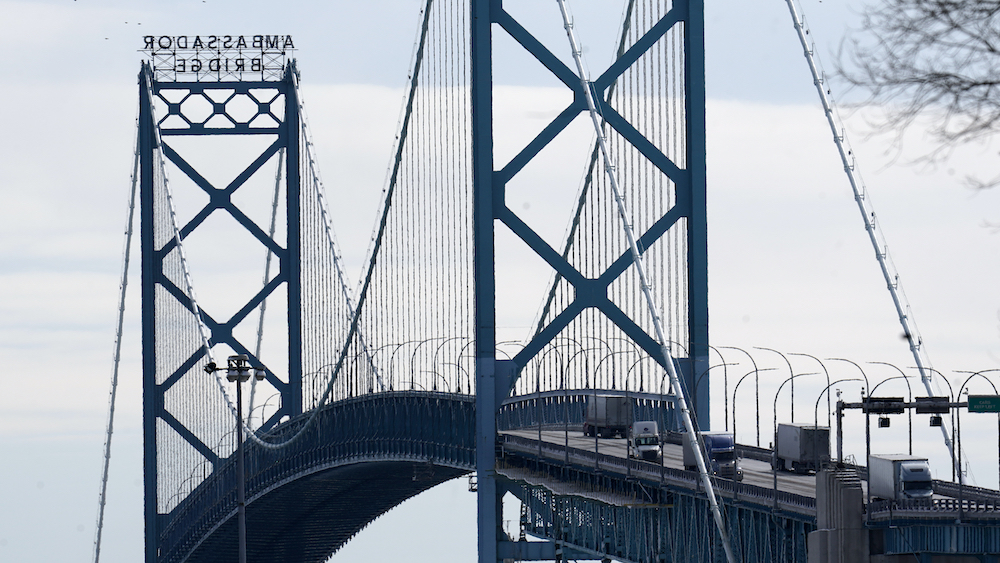February 16, 2022
-Global News
A week-long disruption at North America’s busiest land border crossing has revealed just how dependent the Canadian economy is on the Ambassador Bridge, but experts say there are no simple solutions to offload demand from the critical piece of infrastructure.

Sectors such as the automotive industry rely heavily on the free flow of parts between Michigan and Ontario. This exchange was brought to a standstill at times last week as blockades in solidarity with the so-called “Freedom Convoy” prevented trucks from accessing the Ambassador Bridge.
Though the past weekend’s enforcement efforts effectively cleared the interruptions before Monday, some economists say the fact that goods were stalled for nearly a week demonstrated an over-reliance on the bridge.
“We have always been reliant on the Ambassador Bridge, way too reliant,” says Ambarish Chandra, associate economics professor at the University of Toronto.
Chandra, who focuses specifically on border crossings in his research, notes that while there are a few other crossings in nearby Sarnia, Niagara or farther east of Toronto, they share the same vulnerability as the Ambassador — they cross over bodies of water.
Should the next disruption be a hit to the infrastructure itself, he argues, Canada’s supply chain could take much longer to bounce back.
“We have four or five really big bridge crossings that account for a vast majority of our trade. And if any of those bridges are impassable for some reason — it could be a natural disaster, earthquake, a terrorist attack or anything — we’re stuck.”
Any attempts to circumvent the primary Detroit-Windsor crossing can result in significant delays, with other bridges such as the Blue Water in Sarnia unable to fully accommodate the sheer volume of goods handled by the Ambassador Bridge.
“This is all path dependence,” he says.
“The Ambassador Bridge was built in 1929. It became the biggest bridge very quickly, so all the resources, the staff, were devoted to Detroit, Windsor, so more trucks go there, so all the highways lead there. And so more people, more resources are needed there. You can totally see how history has led us to this point.”
Fresh food vulnerable to Ambassador Bridge disruptions
In addition to automotive, Canada’s agricultural imports and exports rely heavily on the Ambassador Bridge.
Some $8-to-$12 billion worth of food crosses the bridge annually, and roughly a third of that is fruit and vegetable produce, says Simon Somogyi, the Arrell Chair in the Business of Food at the University of Guelph.
“The Canadian food system rides on the back of a truck,” he says.
Most of Canada’s leafy greens and berries, as well as citrus fruit and some fresh and frozen meat, comes across the Ambassador Bridge from producers in Florida or even farther south in Mexico, Somogyi says.
While Somogyi says logistics companies are usually adept at finding workarounds for supply chain snags, sudden disruptions at the Ambassador can have an immediate impact on the quality of fresh foods and getting them on grocery store shelves.
“Not only are they important to our diet, but the issue is they need to get onto our grocery store shelves quickly. So any slowdowns at the border can really reduce the shelf life of that product and therefore it can be wasted or it’s just not as nutritious,” he says.
The recent blockades at the Ambassador should reveal to Canadian authorities how critical it is for rapid enforcement around the bridge to keep goods flowing across the border, Somogyi argues.
“It’s really brought to light how critically important that infrastructure is, which many people may not have thought about in the past,” he says.
“So if there are shutdowns in the future, we really can’t go for having it shut down for seven days. I think that all governments, whether federal, provincial or local, need to act quickly if something like this happens again.”
Efforts to build more bridges, diversify domestic production
Though possible routes exist for shipment by sea or air, trucking has been by-and-large the most cost effective and reliable source of trade between Canada and the U.S., given its substantial land border.
“An alternative for the Ambassador Bridge would only be creating more bridges or creating more thoroughfares through the U.S.,” Somogyi says.
“It may mean governments look at other ways of getting products across to the U.S., but those are going to be long-term. Those will take a lot of time to come to fruition and will be very costly.”
After numerous hurdles, including opposition from the private ownership of the Ambassador Bridge, development is now underway on construction of a parallel crossing, the Gordie Howe International Bridge, with anticipated completion in 2024.
Global News attempted to reach out to representatives of the Ambassador Bridge ownership group, which has both American and Canadian interests, for comment on efforts to prevent future disruptions but did not hear back before publishing.




